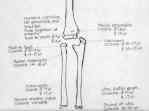- Discussion:
- disease involving capitulum of distal humerus that produced changes similar to those observed in Legg Calve Perthes disease;
- it should be distinguished from osteochondritis dissecans (which occurs in the older child or adolescent - older than age 13 years);
- pathologic process is believed to be caused by an interferrence in blood supply to growing epiphysis, which results in resorption & eventual repair
and replacement of the ossification center;
- in patients under 20 years of age, capitellum is only supplied by end arteries entering posteriorly;
- Panner's disease almost always occurs in the dominant elbow in boys between 5 and 12 years of age;
- inciting causes:
- chronic repetitive trauma, congenital and hereditary factors, embolism (fat), and endocrine disturbances;
- Diff Dx:
- Panner's disease should not be confused w/ more common osteochondritis dessicans of capitulum seen in adolescent boys, which is related to throwing activities;
- throwing injuries:
- although initial x-ray appearance of two conditions may be similar, the progression of the changes differs;
- Clinical manifestations:
- patients report intermittent pain and stiffness in the affected elbow that lasts for several months;
- symptoms are relieved by rest and aggravated by activity;
- on PE local tenderness over capitulum, slight effusion, & synovial thicknening of the elbow joint are found;
- limited extension is typical, lacking 20 to 30 deg of full extension;
- there may be slight loss of pronation and supination w/ tenderness;

- Radiographic changes:
- radiology of pediatric elbow
- initially the capitulum appears irregular with areas of radioluceny (indicating resorption), particularly adjacent to
the articular surface, and sclerosis;
- in 3-5 months, radiographs show larger radiolucent areas followed by reconstruction of the bony epiphysis;
- in 1 to 2 years, the epiphysis returns to its normal configuration w/ no flattening, presumably becausethe elbow is not wt bearing joint;
- in about 50% of pts, adjacent radial head shows early maturation compared with the univolved elbow;
- Treatment:
- symptomatic treatment for Panner's disease is sufficient because epiphysis becomes revascularized & develops normal configuration;
- reducing elbow activities, particularly those that strain the joint, usually relieves pain and allows gradual return of elbow motion;
- however, the use of a long arm cast or splint for 3 to 4 weeks may be necessary until pain, swelling, and local tenderness subside;
- long term outlook is execellent, but a slight loss of elbow extension may persist in some patients;
- of note, as with Perthes disease, the radiographic reovery may lag behind the clinical resolution of symptoms
Arthroscopic Treatment of Panner's Disease.

